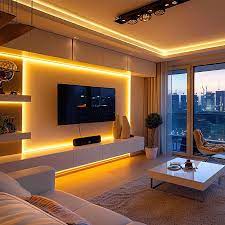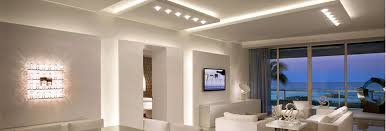Introduction
Lighting is more than just a tool to illuminate spaces — it’s a powerful design element that shapes atmosphere, enhances functionality, and defines how people experience a room. Whether it’s a cozy home, a dynamic office, or a modern commercial space, lighting plays a crucial role in both mood creation and spatial efficiency.
At Gemcon Engineering, lighting design is considered a cornerstone of interior and architectural planning. The company integrates advanced lighting techniques to craft environments that feel inviting, purposeful, and beautifully balanced.

The Psychology of Light: How Lighting Influences Mood
Lighting directly affects how we feel, behave, and interact with our surroundings. Bright, natural light often boosts energy and productivity, while warm, soft lighting can evoke comfort and relaxation.
Different lighting colors and intensities stimulate emotional responses:
- Warm light (yellow/orange tones): Creates a cozy and welcoming feel, ideal for living rooms or restaurants.
- Cool light (white/blue tones): Encourages focus and alertness, making it suitable for offices and classrooms.
- Colored lighting: Adds creativity, drama, or relaxation, depending on hue and saturation.
Gemcon Engineering’s lighting design experts understand these psychological nuances and tailor illumination plans to evoke the desired emotions in every space
How Lighting Shapes Space Functionality
Beyond aesthetics, lighting determines how functional and usable a space truly is. A well-designed lighting plan ensures that each area of a building serves its purpose effectively — from task-oriented brightness in kitchens or workspaces to ambient light in relaxation zones.
1. Ambient Lighting: Setting the Overall Tone
Also known as general lighting, ambient lighting provides uniform illumination across a space. It ensures visibility and comfort while maintaining balance between brightness and mood. Ceiling-mounted fixtures, chandeliers, or recessed lights often serve this purpose.
Gemcon Engineering designs ambient lighting systems that provide even coverage and complement the architectural form of the building.
2. Task Lighting: Enhancing Productivity and Precision
Task lighting focuses light on specific areas where activities like reading, cooking, or working occur. Examples include desk lamps, under-cabinet kitchen lights, and vanity mirrors.
Proper task lighting prevents eye strain and enhances performance. Gemcon Engineering integrates flexible task lighting options to meet both aesthetic and practical needs in residential and commercial spaces.
3. Accent Lighting: Adding Drama and Depth
Accent lighting highlights architectural features, artwork, or textures — creating visual interest and depth. Track lights, spotlights, or LED strips can transform plain walls into design highlights.
At Gemcon Engineering, accent lighting is used strategically to emphasize structure, shape, and beauty, bringing every design element to life.
4. Natural Lighting: Merging Nature and Architecture
Natural light is one of the most sustainable and mood-enhancing lighting sources. Sunlight not only saves energy but also improves mental health and boosts productivity.
Architectural planning at Gemcon Engineering incorporates large windows, skylights, and reflective surfaces to maximize daylight exposure without compromising thermal comfort or privacy
Lighting Design in Different Spaces
1. Residential Spaces
Home lighting design requires a blend of comfort, flexibility, and warmth. Living rooms may use dimmable ambient lighting for relaxation, while kitchens and studies need brighter, task-oriented light. Bedrooms often benefit from soft bedside lamps and layered light for adjustable mood control.
Gemcon Engineering’s interior experts craft personalized lighting layouts that enhance every corner of a home while matching the homeowner’s lifestyle.
2. Commercial Offices
Office lighting significantly affects employee productivity, focus, and energy. Overly harsh light can cause fatigue, while dim light reduces alertness.
Gemcon Engineering creates balanced lighting designs using a mix of natural light and energy-efficient LED systems to maintain optimal brightness and reduce eye strain. Smart lighting systems are often integrated to adjust brightness levels automatically based on occupancy and daylight.
3. Retail and Hospitality Spaces
In retail and hospitality, lighting directly influences customer perception and behavior. Warm, inviting tones can make restaurants and hotels feel cozy, while strategic accent lighting can highlight products or décor in retail stores.
Gemcon Engineering’s designers use lighting to craft immersive experiences that align with brand identity and customer comfort.
The Role of Technology in Modern Lighting Design
The future of lighting design lies in smart, adaptive technologies that respond to human needs and environmental conditions.
Some emerging trends include:
- Smart Lighting Systems: Automated lights controlled by motion sensors or mobile apps.
- Energy-Efficient LEDs: Consuming less power while offering superior brightness and longevity.
- Human-Centric Lighting: Systems that mimic natural daylight patterns to improve health and sleep cycles.
- Dynamic Color Control: Adjusting color temperature and intensity to match time of day or activity.
Gemcon Engineering integrates these technologies into modern construction projects, ensuring that lighting is not only functional but also sustainable and intelligent.
Sustainability Through Lighting Design
Lighting accounts for a significant portion of a building’s energy use. By adopting sustainable lighting solutions, energy consumption can be reduced drastically.
Gemcon Engineering promotes green building practices by:
- Using LED and solar-powered lighting systems.
- Designing layouts that maximize daylight penetration.
- Installing motion sensors and dimmers for energy efficiency.
- Employing reflective surfaces and light-colored interiors to enhance brightness naturally.
These practices not only lower energy bills but also reduce the building’s carbon footprint, contributing to a greener future.
The Art of Layered Lighting
An effective lighting design doesn’t rely on one source alone — it’s about layering different types of light to create harmony and flexibility.
A typical layered lighting plan includes:
- Ambient Lighting for overall illumination.
- Task Lighting for focused activities.
- Accent Lighting for aesthetic enhancement.
This combination adds depth, control, and emotional richness to every environment. Gemcon Engineering uses layered lighting principles in all design projects, ensuring both practicality and visual appeal.
Why Choose Gemcon Engineering for Lighting Design
At Gemcon Engineering, lighting design is more than adding fixtures — it’s about creating experiences. The company’s team of architects, designers, and engineers collaborate to integrate lighting seamlessly with structure, form, and function.
From concept to execution, every project focuses on:
- Enhancing mood and comfort.
- Supporting productivity and safety.
- Ensuring energy efficiency and sustainability.
- Reflecting the client’s aesthetic goals.
With a blend of creativity and technical expertise, Gemcon Engineering ensures that lighting transforms spaces into dynamic, inspiring environments.
Conclusion
Lighting design is both a science and an art — shaping how we perceive, feel, and function within a space. From residential interiors to large-scale commercial projects, thoughtful lighting can transform ordinary environments into extraordinary experiences.
Gemcon Engineering stands at the forefront of innovative lighting design, combining technology, sustainability, and human psychology to create spaces that inspire.
To explore modern architectural and lighting solutions, visit Gemcon Engineering today — and discover how the right light can illuminate your world.

